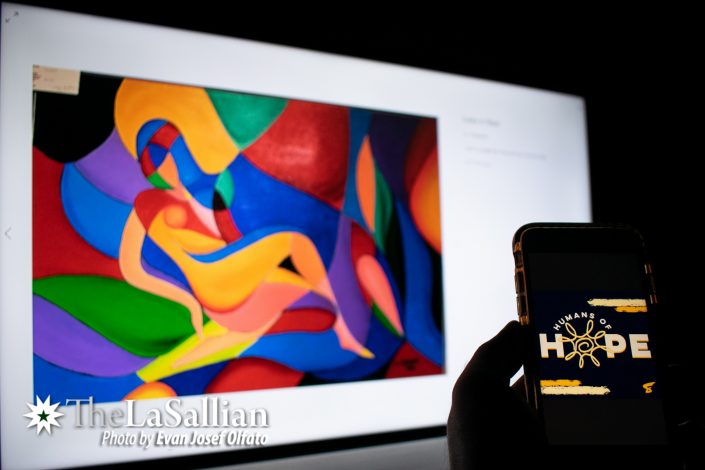The cold confines of prison can be a damning place.
In the time one spends sitting behind bars, an inmate could lose some semblance of hope in such a desolate setting. This desire to help the inmates was what inspired the Servants of the Holy Eucharist to initiate the Restorative Justice Program at Mandaluyong City Jail at the beginning of 2020.
“In formation, teaching, or education, [the inmates’] intellectual capabilities are developed and their moral needs met through religious instructions, guidance and counseling, recollections, seminars and conferences,” shares Sr. Zenaida Cabrera, sister superior of the Servants of the Holy Eucharist.
With the goal of providing an avenue for detained individuals to express themselves, the program—through the efforts of the inmates—has produced a number of paintings, which were presented by Santugon sa Tawag ng Panahon in an online exhibit titled Humans of Hope. There, the inmates’ artworks are on full display, alongside an accompanying title and description written by the inmates themselves, as well as details for purchase, with the proceeds to be directly sent to the inmates’ families. It is through this exhibition of craftsmanship and candor that the stories of the people behind the colors and brushstrokes might be brought to light.
Change of plans
The idea behind Humans of Hope came when Santugon first heard of the budding restoration program. “Connected kami with the Mandaluyong City Jail because we knew the sisters there,” explains Alyanna Apostol (II, PHY-PMD), one of the project heads. “That was where the concept of the project came from. It’s to raise money for the paintings that [the inmates] make, and at the same time, [to] share their stories.”
Before quarantine measures were put in place, there were plans to put up a physical exhibit on the sixth floor of Henry Sy Sr. Hall. However, as has been the case with many events this year, circumstances forced them to migrate online.
“The physical exhibit was actually supposed to happen [around] April,” shares project head Sarah Gordon (I, IE-IT). “When it got canceled…we had to put it on pause because we didn’t really know how to go about it. [The online exhibit is] a different approach but it’s just a way for us to continue the project because we really didn’t want to let it go.”
Narrative on display
The artworks on display resonate with the viewer on a visual and emotional level; beyond the hues and outlines, each piece provides a glimpse into the painful narrative the artist attempts to convey.
One painting, Manlalayag by Warlie Susa, stages a scene of fishing boats across the sea, their shadows facing the viewers as the background is cast in an orange hue. While the piece evokes somber, nostalgic emotions, the story behind it also tugs at the heartstrings.
“[The artist took revenge] on the man who killed his brother,” discloses fellow project head Bryanna Go (II, MKT). With Susa as the designated caretaker of his brother’s children, Go explains, “The painting is mostly about how they used to go out fishing for their livelihood and how to survive.”
Another painting, Oyayi by Gilbert Orzaga, depicts a mother holding her child close, her eyes closed peacefully as she cradles him. There is a softness to the imagery on display, with varying shades of brown being used to accentuate the warmth of a mother’s love. The description of the painting describes this as a reminder of the artist’s own experience: he was imprisoned when his child was still an infant, and the work on display reflects a deep longing to be able to hold his own child in his arms.

Art and artist
A common thread that ties the artists of Humans of Hope is that many, if not all, of them picked up the brush while serving their life sentences. As an outlet for self-expression and introspection, the Restorative Justice Program has become an avenue for these individuals to breathe life into an empty canvas, reminding us that they are unmistakably human.
Exhibits like Humans of Hope may stir discussion on the notion of separating art from the artist. Because art is so richly entangled with the circumstances of the artist behind it, many may find it difficult to separate one from the other. But perhaps such gray areas are what the project is unveiling—recognizing the larger societal, often systemic issues that impede upon personal lives, these complex narratives can validly be brought to light. On a metaphysical level, the prevailing theme of the exhibit is the duality of humans: they are capable of both causing severe harm and creating stunning beauty.
“They are and [will] remain human beings and should be treated as such,” Cabrera stresses. “The relationship we develop with them is vital…We can accompany them and assist them [in regaining] their personal identity and dignity as [people].”
This is the message that the program aims to send to viewers of these artworks. Cabrera highlights the capacity of the Humans of Hope project to bring these inmates’ stories to a public audience, creating a positive impact inside and outside the walls of their cells.
“A social cause-oriented organization like Santugon, [whose] sponsored exhibit on the artworks of the Mandaluyong Jail inmates…[has] created a positive effect and strong impact on [the inmates’ lives], encouraged them and inspired them to live, move forward and onward to their freedom,” she attests.
The circumstances behind the lives of the prisoners serve as the lifeblood for Humans of Hope, adding to the plethora of artworks that paint a picture of life in the Philippines. The artworks’ themes of family, religion, nature, and poverty, coupled with their accompanying descriptions, put into perspective the gripping realities that artists like Orzaga and Susa have faced in their lives.
“This way, we’re still treating them like people. We’re not shunning them from society because they made a mistake,” Gordon comments. “We’re just trying to show people that despite their faults, they are still human and there is still hope.”
